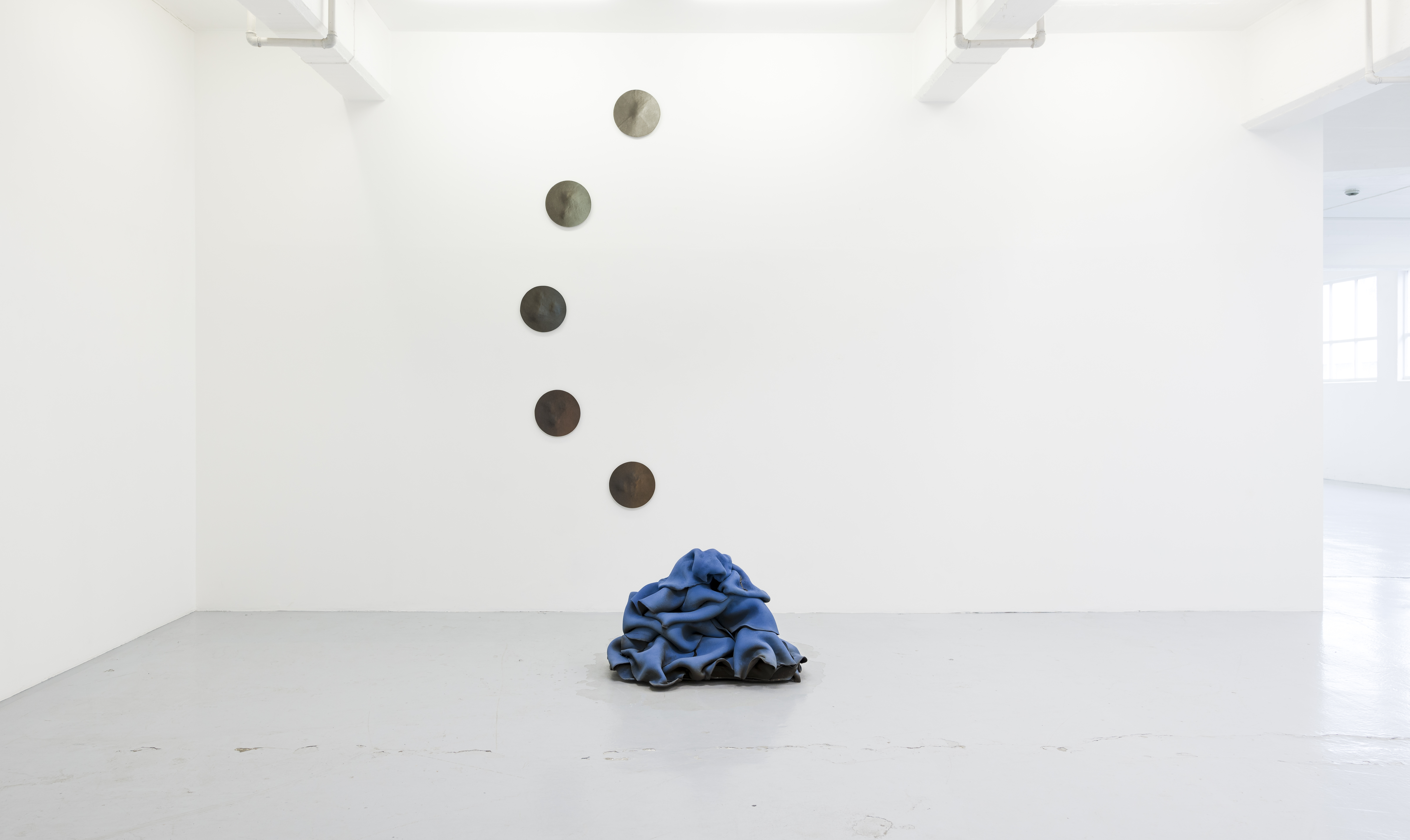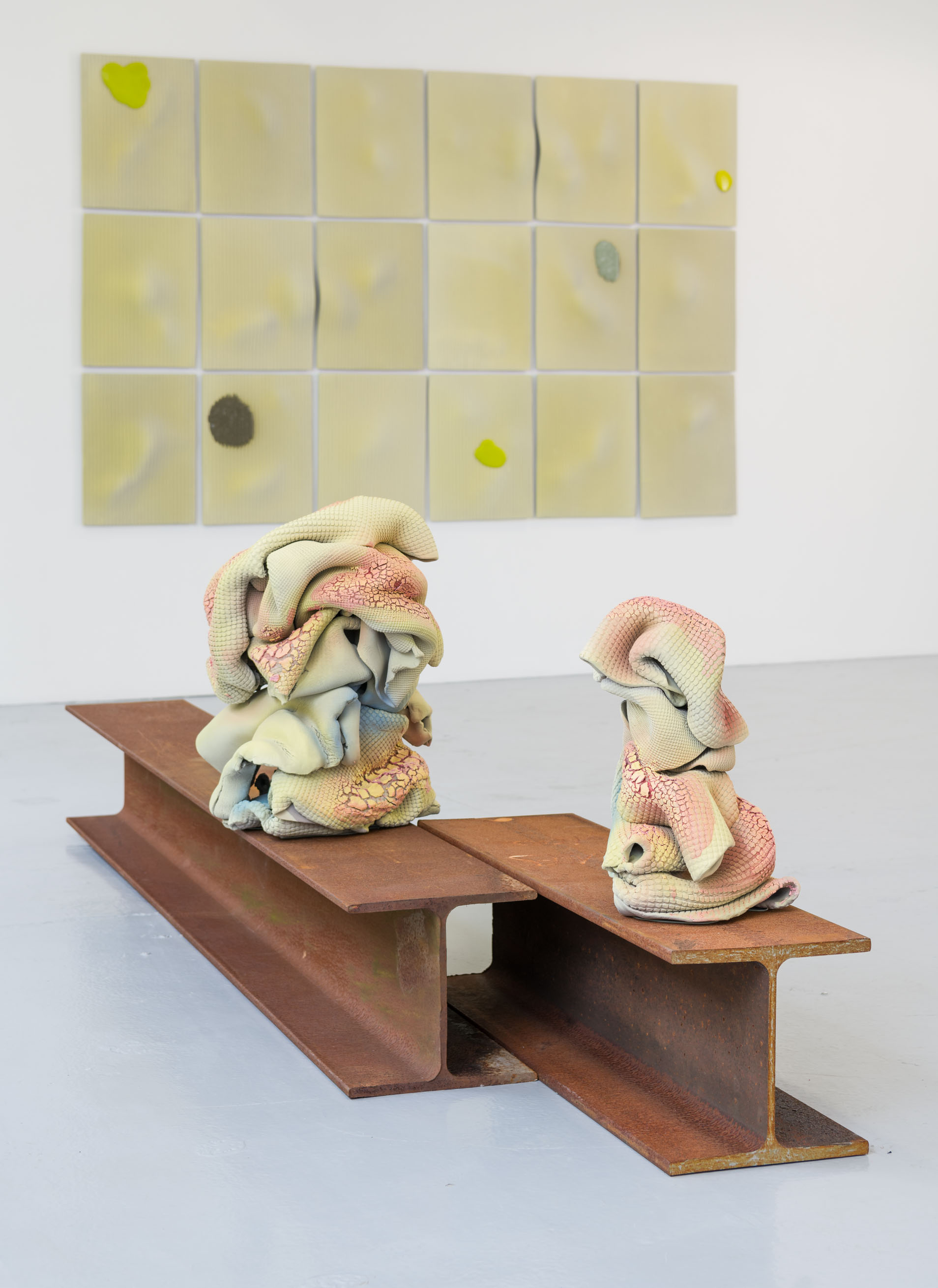
TITLE
MEDIA
DATES
August 18, 2023 –
] Instar [
MEDIA
ceramic, glass, engobe, glaze, steel beams, water, waterplants
DATES
August 18, 2023 –
September 16, 2023
SOLO EXHIBITION
LOCATION
Galleri Opdahl
LOCATION
Stavanger, Norway








The electric color palate of the new works that make up ] Instar [ (2023) is inspired by the tumultuous and otherworldly volcanic landscape of the Danakil Depression, a geologic depression in the Afar region of Ethiopia and one of the hottest and lowest points on Earth. The show returns to Kox’s fixation on metamorphoses between somewhat unlikely bedfellows, molting insects and molten lava. From Rebecca Solnit’s A Field Guide to Getting Lost (2005): “The strange resonant word instar describes the stage between two successive molts, for as it grows, a caterpillar, like a snake, like Cabeza de Vaca walking across the Southeast, splits its skin again and again, each stage an instar.” ] Instar [ focuses on the time and the body between fixed phases, a kind of adolescence that might remind us of the deep scale of Earth’s existence before us and how long after us it will remain. It explores the landscape through a tension felt across the exhibition space between dry volcanic forms, cracked and sun-yellow like the sulfuric saltscape of the Afar, and others in deeper varied hues partially submerged on beams in a shallow pool bobbing with live water plants. On the wall a lime-like green, almost iridescent topography in 18 squares arranged like pieces of a map seen from above. Undulating, liquidy ripples across squares as if under the wall’s skin, throwing it into motion. A dizzying effect as you, too, move, colors changing from grey to yellow and back. A map that disorients, refuses to fix you in any singular place.
Bubbling crater lakes of lava, active volcanos, sulfuric hot springs, hypersaline lakes - this is one of the most extreme regions on Earth. Ursula K. Le Guin: “We are volcanoes. When we women offer our experience as truth, as human truth, all the maps change. There are new mountains.” Kox’s work indeed forms new mountains, remakes landscapes inspired by feminist ecologies and speculative fictions, by the memories that the materials and the land holds. The Afar region is thought by some to be the very place where the human species first evolved. AL 288-1 or “Lucy,” the remains of a hominin species Australopithecus afarensis was discovered here in 1974. Recent studies claim that parts of the region, especially its bodies of water, are devoid of even microbial life. The site is therefore of special interest to astrobiologists who study lifeforms in extreme environments that make it more feasible to imagine extraterrestrial life (she is so aptly named after the Beatles’ “Lucy in the Sky with Diamonds”). Once a possible origin of the so-called human, now a site through which the posthuman and the extraterrestrial are sought and imagined.
Too extreme. Too much salinity. Too hot. Too dry. In its invocation of the Danakil Depression, ] Instar [ considers in part an ecology without life (as we know it). Stefan Helmreich: “[t]he limits of life, the boundaries of vitality, may yet be unknown. Scientists are still chasing ‘after nature,’ but are now doing so by looking to the stars, for yet-to-be-characterized conditions, yet-to-be-known ‘extremes’ relative to which life might be able to survive.” There is something “after” about Kox’s works in the sculptures’ evocations of being leftover, discarded skins of creatures unknown, technological debris as well as in their speculative posthuman-like environs — beings and places from another world. Solnit also invokes the stars, a deep history as the background to all of life on earth: “Instar implies something both celestial and ingrown, something heavenly and disastrous, and perhaps change is commonly like that, a buried star, oscillating between near and far.” Temporalities and scales of vast incongruencies on display, this exhibition is about what is here as much as it is about what will be left here long after we are gone. Wallace Stevens, from “Postcard from a Volcano” (1923): “Children picking up our bones / Will never know that these were once / As quick as foxes on the hill; /And that in autumn, when the grapes / Made sharp air sharper by their smell / These had a being, breathing frost; / And least will guess that with our bones / We left much more, left what still is / The look of things, left what we felt / At what we saw.”
Alison Sperling
Bubbling crater lakes of lava, active volcanos, sulfuric hot springs, hypersaline lakes - this is one of the most extreme regions on Earth. Ursula K. Le Guin: “We are volcanoes. When we women offer our experience as truth, as human truth, all the maps change. There are new mountains.” Kox’s work indeed forms new mountains, remakes landscapes inspired by feminist ecologies and speculative fictions, by the memories that the materials and the land holds. The Afar region is thought by some to be the very place where the human species first evolved. AL 288-1 or “Lucy,” the remains of a hominin species Australopithecus afarensis was discovered here in 1974. Recent studies claim that parts of the region, especially its bodies of water, are devoid of even microbial life. The site is therefore of special interest to astrobiologists who study lifeforms in extreme environments that make it more feasible to imagine extraterrestrial life (she is so aptly named after the Beatles’ “Lucy in the Sky with Diamonds”). Once a possible origin of the so-called human, now a site through which the posthuman and the extraterrestrial are sought and imagined.
Too extreme. Too much salinity. Too hot. Too dry. In its invocation of the Danakil Depression, ] Instar [ considers in part an ecology without life (as we know it). Stefan Helmreich: “[t]he limits of life, the boundaries of vitality, may yet be unknown. Scientists are still chasing ‘after nature,’ but are now doing so by looking to the stars, for yet-to-be-characterized conditions, yet-to-be-known ‘extremes’ relative to which life might be able to survive.” There is something “after” about Kox’s works in the sculptures’ evocations of being leftover, discarded skins of creatures unknown, technological debris as well as in their speculative posthuman-like environs — beings and places from another world. Solnit also invokes the stars, a deep history as the background to all of life on earth: “Instar implies something both celestial and ingrown, something heavenly and disastrous, and perhaps change is commonly like that, a buried star, oscillating between near and far.” Temporalities and scales of vast incongruencies on display, this exhibition is about what is here as much as it is about what will be left here long after we are gone. Wallace Stevens, from “Postcard from a Volcano” (1923): “Children picking up our bones / Will never know that these were once / As quick as foxes on the hill; /And that in autumn, when the grapes / Made sharp air sharper by their smell / These had a being, breathing frost; / And least will guess that with our bones / We left much more, left what still is / The look of things, left what we felt / At what we saw.”
Alison Sperling